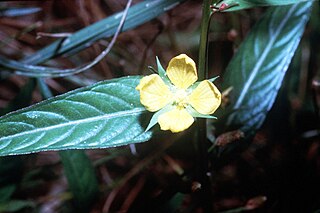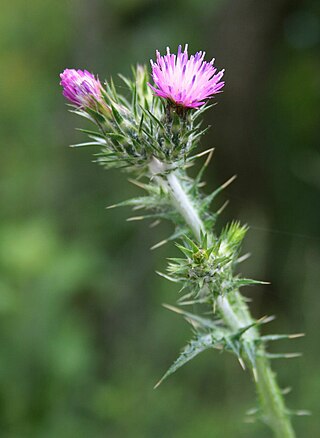
Aquatic plants are plants that have adapted to living in aquatic environments. They are also referred to as hydrophytes or macrophytes to distinguish them from algae and other microphytes. A macrophyte is a plant that grows in or near water and is either emergent, submergent, or floating. In lakes and rivers macrophytes provide cover for fish, substrate for aquatic invertebrates, produce oxygen, and act as food for some fish and wildlife.

Primula is a genus of herbaceous flowering plants in the family Primulaceae. They include the primrose, a familiar wildflower of banks and verges. Other common species are P. auricula (auricula), P. veris (cowslip), and P. elatior (oxlip). These species and many others are valued for their ornamental flowers. They have been extensively cultivated and hybridised. Primula are native to the temperate Northern Hemisphere, south into tropical mountains in Ethiopia, Indonesia, and New Guinea, and in temperate southern South America. Almost half of the known species are from the Himalayas.

Primula veris, the cowslip, common cowslip, or cowslip primrose, is a herbaceous perennial flowering plant in the primrose family Primulaceae. The species is native throughout most of temperate Europe and western Asia, and although absent from more northerly areas including much of northwest Scotland, it reappears in northernmost Sutherland and Orkney and in Scandinavia. This species frequently hybridizes with other Primulas such as the common primrose Primula vulgaris to form false oxlip which is often confused with true oxlip, a much rarer plant.

The Onagraceae are a family of flowering plants known as the willowherb family or evening primrose family. They include about 650 species of herbs, shrubs, and trees in 17 genera. The family is widespread, occurring on every continent from boreal to tropical regions.

Taxodium distichum is a deciduous conifer in the family Cupressaceae. It is native to the southeastern United States. Hardy and tough, this tree adapts to a wide range of soil types, whether wet, salty, dry, or swampy. It is noted for the russet-red fall color of its lacy needles.

Oenothera biennis, the common evening-primrose, is a species of flowering plant in the family Onagraceae, native to eastern and central North America, from Newfoundland west to Alberta, southeast to Florida, and southwest to Texas, and widely naturalized elsewhere in temperate and subtropical regions. Evening primrose oil is produced from the plant.

Ludwigia is a genus of about 82 species of aquatic plants with a cosmopolitan but mainly tropical distribution.

Ludwigia alternifolia, commonly known as seedbox, bushy seedbox, rattlebox, and square-pod water-primrose, is a herbaceous perennial plant of the family Onagraceae. It is native to central and eastern North America, growing in marshes, wet meadows, and swamps. It has yellow, four-petaled flowers and brown seed pods that are shaped like a cube.

Carduus pycnocephalus, with common names including Italian thistle, Italian plumeless thistle, and Plymouth thistle, is a species of thistle. It is native to the Mediterranean region in southern Europe, North Africa, and Western Asia; Eastern Europe and the Caucasus; and the Indian Subcontinent.

Alloxylon flammeum, commonly known as the Queensland tree waratah or red silky oak, is a medium-sized tree of the family Proteaceae found in the Queensland tropical rain forests of northeastern Australia. It has shiny green elliptical leaves up to 18 cm (7.1 in) long, and prominent orange-red inflorescences that appear from August to October, followed by rectangular woody seed pods that ripen in February and March. Juvenile plants have large deeply lobed pinnate leaves. Previously known as Oreocallis wickhamii, the initial specimen turned out to be a different species to the one cultivated and hence a new scientific name was required. Described formally by Peter Weston and Mike Crisp in 1991, A. flammeum was designated the type species of the genus Alloxylon. This genus contains the four species previously classified in Oreocallis that are found in Australasia.

Nymphaea nouchali, often known by its synonym Nymphaea stellata, or by common names blue lotus, star lotus, red water lily, dwarf aquarium lily, blue water lily, blue star water lily or manel flower, is a water lily of genus Nymphaea. It is native to southern and eastern parts of Asia, and is the national flower of Bangladesh and Sri Lanka. In Sanskrit it is called utpala. This species is usually considered to include the blue Egyptian lotus N. nouchali var. caerulea. In the past, taxonomic confusion has occurred, with the name Nymphaea nouchali incorrectly applied to Nymphaea pubescens.

Ludwigia palustris is a species of flowering plant in the evening primrose family known by the common names marsh seedbox, Hampshire-purslane and water purslane. This is an aquatic or semiaquatic perennial herb which grows in moist to wet to flooded areas. It is sometimes a weed. The species epithet palustris is Latin for "of the marsh" and indicates its common habitat.

Ludwigia peploides is a species of flowering plant in the evening primrose family known by the common names floating primrose-willow and creeping water primrose. It is native to Australia, New Zealand, North America, and South America, but it can be found on many continents and spreads easily to become naturalized. It is well known as a troublesome aquatic noxious weed that invades water ecosystems and can clog waterways. This is perennial herb which grows in moist to wet to flooded areas. The stem can creep over 2 meters long, sometimes branching. It spreads to form mats on the mud, or floats ascending in the water. The leaves are several centimeters long and are borne in alternately arranged clusters along the stem. The flower has 5 to 6 lance-shaped sepals beneath a corolla of 5 or 6 bright yellow petals up to 2.4 centimeters long. The fruit is a hard, cylindrical capsule.

Ludwigia decurrens is a species of flowering plant in the evening primrose family known by the common names willow primrose and wingleaf primrose-willow. It is native to the central and eastern United States.

Ludwigia glandulosa, the cylindricfruit primrose-willow, is an amphibious plant from southeast United States. It can grow partially or fully submerged. It grows very slowly and needs carbon dioxide in order to grow well. The leaves of this plant will turn greener if insufficient light is provided.
Iris leptophylla is a plant species in the genus Iris, it is also in the subgenus Iris and in the section Pseudoregelia. It is a rhizomatous perennial, from China. It has thin, long grey-green leaves, long slender stem and 2 fragrant purple, blue-purple, violet or lavender pink flowers. It is cultivated as an ornamental plant in temperate regions.

Ludwigia octovalvis is a species of flowering plant in the Onagraceae family known by the common name Mexican primrose-willow. Its native distribution is unclear, but can be found in Central America, Australia, South-East Asia, Tamilnadu (IND), the Middle East, the Central-West African regions and spreads easily to become naturalized. It is also cultivated as an aquatic plant. The plant is known for its anti-aging properties. The species is sometimes regarded as an invasive species and is classified by IUCN as of "least concern" with stable populations. An adult plant is one meter tall on average but is able to grow taller. It spreads to form mats on the mud, rooting at nodes in contact with the substrate, or floats ascending in the water. Its flowers are yellow in appearance. They are made up of green and red stems. They yield small capsular fruits containing many minute seeds.

Ludwigia peruviana, with the common names Peruvian primrose-willow or Peruvian water primrose, is an aquatic, sometimes deciduous species of flowering plant in the evening primrose family. It can grow to approximately 12 feet (3.7 m) in height. While native to Peru, it has been introduced in many other countries for its attractive simple yellow flowers, it is now a common weed in swampy areas around the world.
Ludwigia pilosa, the hairy primrose-willow, is a species of plant in the family Onagraceae.

Ludwigia grandiflora, the water primrose, is an aquatic plant of the order Myrtales.




















